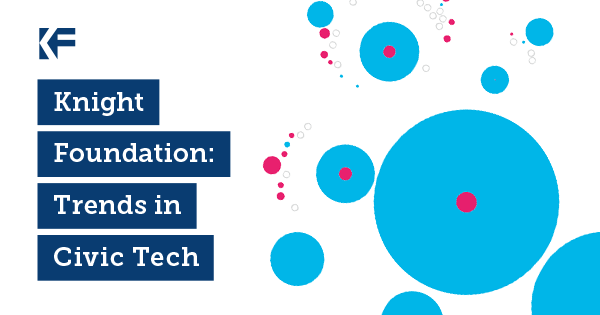
Knight Foundation’s civic tech report: why it matters
Tom Steinberg is the founder and director of mySociety, a nonprofit that helps people become more effective in civic life through digital technology. Below, he writes about the new report from Knight Foundation, “The Emergence of Civic Tech: Investments in a Growing Field.”
At mySociety, we welcome the report Knight Foundation recently released. According to the analysis, in two years funders have invested more than $430 million in “civic tech”—that is, technology that spurs citizen engagement, improves communities and makes governments more effective.Related links
“Pulling back the curtain on civic tech” by Jon Sotsky on Knight Blog
“New tools produce better understanding of investments in civic tech” by Sean Gourley on KnightBlog
“Strange bedfellows or yin and yang” by Stacy Donohue on KnightBlog
“The Emergence of Civic Tech: Investments in a Growing Field” on Slideshare.net
“Civic Tech Directory.xslx,” a landscape list of civic technology projects by Jon Sotsky (link updated 2/28)
“Civic tech report helps ID opportunities in the field” by Keya Dannenbaum on KnightBlog
“Urban neighborhoods take small steps into ‘civic tech‘” by Patrick Barry on KnightBlog
The report examines where this investment comes from and the types of projects funded. You might say that’s highly relevant to our interests; after all, this is precisely the type of work we do at mySociety, and a large proportion of the funding for our projects comes through such investment (disclosure: We are a Knight grantee).
Knight Foundation has been a precocious, voluminous experimenter in the civic tech field, so it’s great to see them stepping back to analyze what’s going on. Experimentation is admirable, and when it’s guided by thoughtful analysis, it’s all the more so. When that research benefits others in the community, it’s a win all around.
For us, and for organizations like us, Knight Foundation’s detailed analysis allows a far wider view than we’ve previously had. It lets us see exactly where we fit into the whole picture.
For example, the analysis shows that the fastest-growing civic tech area is peer-to-peer lending and renting of goods and services. Have a power drill that you only use once or twice a year? These types of projects are trying to bring about a situation where there’s more reusing of stuff, and less of it sitting idle.
MySociety has never ventured into this area, although we have had some similar ideas submitted when we’ve asked for proposals. But, like many of our projects, the peer-to-peer sharing idea is underpinned by a sense of the value of community building and empowerment (as well as, let’s be honest, some attractive business models for investors).
Elsewhere in the report we were interested to see the insights into types of investors and the breakdown of their investing patterns. The report shows that private funders back fewer initiatives than grant funders, but they invest much larger sums. This is thought-provoking data about the different risk models funders are clearly pursuing.
But for me, the biggest surprise in the report is the observation that “relatively little co-investment currently occurs in the civic tech field, especially between philanthropic institutions and other types of investors.” This is very different from mainstream private Internet investment (a company like Facebook had several funders even from the early stages) and we think it’s well worth pausing to ask why this might be—and what might be done about it.
We hope that this is just the beginning of a trend towards analysis and research in our field. Detailed understanding is useful in a number of ways: It informs our future activities, and it adds credibility to our work in the wider world.
We look forward to more of these insights. In fact, we hope we’ll soon be contributing some of our own: In the next year we’re planning to increase our focus on quantifying the civic impacts of our own civic tech—and we’ll be delighted to contribute our insights to the wider community, once we have news to share.
Recent Content
-
Communitiesarticle ·
-
Communitiesarticle ·
-
Communitiesarticle ·


